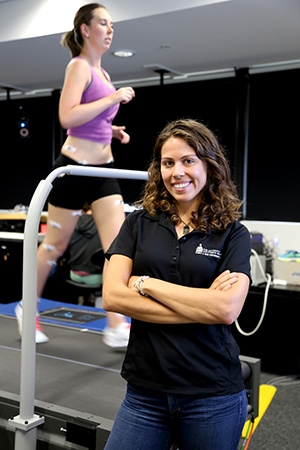Running start for US researcher at Deakin
Research news
Running shoes that tell their wearer when they need to be replaced, or that can be individually customised to suit their wearer’s gait?
These ideas are not as far-fetched as they sound, according to PhD student Nadine Lippa, who has just completed a four-and-a-half-month Endeavour Research Fellowship at Deakin.
Ms Lippa’s ground-breaking research has focussed on how shoes degrade and how runner biomechanics change as a result of that degradation – and her findings are awaited with strong interest by recreational runners, elite athletes and shoe manufacturers alike. So much so, that she has already been sought for an internship with a multinational sports company in Europe once she completes her main PhD research.
Ms Lippa’s work at Deakin is the culmination of her PhD project at the University of Southern Mississippi and will result in a premiere peer-reviewed study bridging human biomechanics (mechanical laws relating to human movement) and polymer degradation.
Her project has focussed specifically on the connections between biomechanics and the performance of ethylene vinyl acetate (EVA) in footwear midsole foam. EVA is used in over 90 per cent of running footwear, for its lightness, flexibility and rebound qualities. Its main drawbacks are that the soft foam can become compressed over time, becoming “compression set.” Researchers believe this disadvantage may lead to injury.
“My PhD has been a great opportunity to expand my thinking about footwear degradation, and ways that we can design better performing shoes,” Ms Lippa said.
“We are trying to identify when running shoes have reached the end of their effective life. If users know how to wear their shoes and when to throw them away, we hope there will be a marked reduction in running injuries.”
How long a shoe lasts depends on a number of variables, she explained, including the runner’s height, weight, recovery rate, gait, training regimen, and the distance covered.
To assess the biomechanical effect of shoe degradation on the runner, the research team used female athletes to trial two styles of running shoe: traditional and minimalist (thinner-soled), and measured the kinematic effects on their joints and gait at different points of degradation.
At the University of Southern Mississippi, advised by Dr Trent Gould and Dr James Rawlins, Ms Lippa also undertook intensive testing of the material, exposing EVA to thermal, mechanical and ultraviolet stressors, to measure consequential effects on the material.
Ms Lippa’s passion for sports and engineering has driven her research journey. As an undergrad, she double majored in Biomechanical Engineering and Materials Science, while playing university soccer at Carnegie Mellon University in Pennsylvania. She is still an avid sportswoman, competing in triathlons and teaching yoga. During her visit to Geelong, she has taken up rowing, attended soccer and rugby matches, and seen the Geelong Cats at Kardinia Park.
She said she has been “blown away by the world class facilities at Deakin.”
“I have used the biomechanics lab, the force plate instrumented treadmill (to asses balance, gait and other biomechanics parameters), the motion capture facilities, and equipment at the Institute for Frontier Materials. It is rare for all of these facilities to be available at one university.”
Her research is uniquely aligned with multi-disciplinary research being conducted at Deakin across two schools: Engineering (led by Dr Paul Collins); and Exercise and Nutrition Sciences (led by Dr Jason Bonacci). Amongst other projects, the researchers completed a major study on the biomechanics of running two years ago.
The Deakin team is also currently working on developing running shoes that can be tuned to individual gaits and created through 3D printing. Dr Collins is optimistic that this could be a commercial option within the next 10 years.
“Using biomechanics, we can see how individuals strike the ground and then design shoes for each individual, to improve their running gait and reduce the stress on their knees,” he said.
In the long-term, the researchers agree, creating shoes that are as good on day one as they are on day 500 is the ultimate goal.
“One day, it should be possible to produce shoes that heal themselves, through self-healing polymers,” said Dr Collins. “Deakin’s Professor Qipeng Guo is a world expert in this field and is exploring new technology to create polymers that can easily regenerate, that is, autonomously heal at room temperature, within a few minutes.”
Share this story
 Visiting US researcher, Nadine Lippa, with research participant Gemma Hutley on the treadmill.
Visiting US researcher, Nadine Lippa, with research participant Gemma Hutley on the treadmill.
